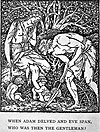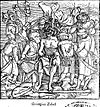List of peasant revolts
Appearance
This is a chronological list of conflicts in which peasants played a significant role.
Background
History of peasant wars spans over a period of over two thousand years. A variety of reasons fueled the emergence of the peasant revolt phenomenon, including:[1]
- Tax resistance
- Social inequality
- Religious war
- National liberation
- Resistance against serfdom
- Redistribution of land
- External factors such as plague and famine
Later peasant revolts such as the Telangana Rebellion were also influenced by agrarian socialist ideologies.[2]
The majority of peasant rebellions ended prematurely and were unsuccessful. Peasants suffered from limited funding and lacked the training and organisational capabilities of professional armies.[3]
Chronological list
The list gives the name, the date, the peasant allies and enemies, and the result of these conflicts following this legend:
- Peasant victory
- Peasant defeat
- Another result (e.g. a treaty or peace without a clear result, status quo ante bellum, result unknown or indecisive)
- Ongoing conflict
| Date | Conflict | State | Peasants | Result | Image | References |
|---|---|---|---|---|---|---|
| 209-206 BC | Anti-Qin revolts (including Dazexiang Uprising) | Qin dynasty | Peasants under several rebel leaders, including Chen Sheng, Wu Guang, Xiang Yu, and Liu Bang | Qin dissolution | [4] | |
| 205–186 BC | Great revolt of the Egyptians | Native Egyptian peasants and soldiers under secessionist Pharaohs Hugronaphor and Ankhmakis | Suppression of the rebellion | [5] | ||
| 17-25 | Lülin | Xin dynasty | Lülin rebels | Collapse of Xin dynasty; ascendancy of rebel leader Liu Xiu after infighting among Lülin forces | ||
| 17-27 | Red Eyebrows | Xin dynasty | Red Eyebrows rebels | Goal of the rebellion partially achieved, but eventual defeat of the movement by Liu Xiu | ||
| 172-173 | Bucolic War | Egyptian peasants under Isidorus | Suppression of the rebellion | [6] | ||
| 184–205 | Yellow Turban Rebellion | Han dynasty | Yellow Turban rebels | Suppression of the rebellion, though Han dynasty is severely weakened | 
|
[7] |
| 185–205 | Heishan bandit movement | Han dynasty | Bandit confederacy of the Taihang Mountains Gongsun Zan's forces | Suppression of the rebellion, though Han dynasty is severely weakened | ||
| 3rd – 5th century | Bagaudae | Bagaudae Suebi | Gain control of some territory; end with the general collpase of the Roman Empire | |||
| 4th – late 5th century | Circumcellions | Berber and Roman peasants Donatist authorities Rebellious Roman military under Gildo (in 398) | End of Roman Catholic rule in Africa, but suppression of the rebellion by Vandals and Arian authorities | [8] | ||
| 611-619 | Anti-Sui rebellions | Sui dynasty | Peasants under several rebel leaders Defected military forces under several rebel generals, officials and nobles | Collapse of Sui dynasty; ascendancy of rebel leader Li Yuan after infighting among rebel forces | ||
| 841–843 | Stellinga Uprising | Saxon nobility Frankish military under Louis the German | Stellinga | Suppression of the rebellion | ||
| 859–860 | Rebellion of Ch'iu Fu | Tang dynasty | Chinese peasants and bandits under Ch'iu Fu | Suppression of the rebellion, though Tang dynasty is severely weakened | [9] | |
| 874–878 | Rebellion of Wang Xianzhi | Tang dynasty | Chinese peasants and bandits under Wang Xianzhi and Shang Junzhang | Suppression of the rebellion, though Tang dynasty is severely weakened | [10] | |
| 875–884 | Rebellion of Huang Chao | Tang dynasty | Chinese peasants and bandits under Huang Chao | Suppression of the rebellion, though Tang dynasty is severely weakened | [11] | |
| 928–932 | Basil the Copper Hand Rebellions | Peasants under Basil the Copper Hand | Suppression of the rebellion | [12] | ||
| 993-995 | Da Shu rebellion in Sichuan | Song dynasty | Peasants under Wang Xiaobo and Li Shun | Suppression of the rebellion | [13] | |
| 1277–1280 | Uprising of Ivaylo | Murder of Ivaylo | [14] | |||
| 1323–1328 | Peasant revolt in Flanders | Flemish peasants | Suppression of the rebellion | 
|
||
| 1343–1346 | St. George's Night Uprising | Estonian peasants | Suppression of the rebellion | 
|
[15] | |
| 1351-1368 | Red Turban Rebellion | Yuan dynasty Goryeo | Red Turban Armies of White Lotus members, Manichaeans and Chinese peasants | Fall of Yuan dynasty and retreat of the Mongols into Mongolia as the Northern Yuan dynasty; ascendancy of rebel leader Zhu Yuanzhang after infighting among rebel forces | ||
| 1358 | Jacquerie | French peasants | Suppression of the rebellion | 
|
||
| 1381 | Peasants' Revolt | English peasants | Suppression of the rebellion | 
|
||
| 1382 | Harelle | French peasants | Suppression of the rebellion | 
|
[16] | |
| 1401–1404, 1409 | Samogitian uprisings | Samogitian peasants |
Goal of the rebellion largely achieved, though disputes over Samogitia continue until 1422 | |||
| 1428 | Shocho uprising | Muromachi Shogunate | Japanese peasants | Peasant debts cancelled. | ||
| 1437 | Budai Nagy Antal Revolt | Transylvanian peasants | Suppression of the rebellion | |||
| 1441 | Funen and Jutland Peasant rebellions | Danish peasants | Suppression of the rebellion | 
|
||
| 1450 | Jack Cade Revolt | English peasants | Suppression of the rebellion | 
|
[17] | |
| 1450–1451 | John and William Merfold's Uprising | English peasants | Suppression of the rebellion | 
|
[18] | |
| 1453–1454 | Morea revolt of 1453–54 | Greek peasants under Manuel Kantakouzenos Albanians under Peter Bua |
Suppression of the rebellion | [19] | ||
| 1462–1472, 1485–1486 | Remença | Catalan peasants |
Goal of the rebellion largely achieved, Sentència de Guadalupe signed | 
|
[20] | |
| 1478 | Carinthian Peasant Revolt | Carinthian peasants | Suppression of the rebellion | 
|
[21] | |
| 1482–1511 | Yamashiro-ikki uprisings | Yamashiro peasant leagues Hatakeyama clan |
Most ikki submit to the shogunate in 1493, though continue to retain autonomy until gradual dissolution of the movement | [22] | ||
| 1487-1488 | Kaga Rebellion | Togashi clan | Ikkō-ikkiMotoori clanYamagawa clan | Decisive victory for the Ikkō-ikki. | 
|
[23] |
| 1488–1582 | Ikkō-ikki Uprisings | Several major samurai clans (including Oda clan and Tokugawa clan) Nichiren sect Tendai sōhei Jōdo-shū sōhei | Ikkō-shū peasant and ji-samurai leagues Jōdo Shinshū sōhei |
Destruction of most militant Ikkō-shū leagues; Jōdo Shinshū sect and remaining Ikkō-ikki submit to Toyotomi Hideyoshi | [24] | |
| 1498–1878 | Opryshky movement | Ukrainian peasants | Suppression of the movement | 
|
||
| 1511 | Friulian Revolt | Friulian peasants | Suppression of the rebellion | 
|
||
| 1514 | Poor Conrad Rebellion | Württemberg peasants | Suppression of the rebellion | 
|
[25] | |
| 1514 | György Dózsa Rebellion | Hungarian peasants | Suppression of the rebellion | 
|
[26] | |
| 1515 | Slovene Peasant Revolt | Slovene peasants | Suppression of the rebellion | [27] | ||
| 1515–1523 | Frisian peasant rebellion | Suppression of the rebellion | 
|
|||
| 1516–1521 | Trần Cảo Rebellion | Lê dynasty | Vietnamese peasants under Trần Cảo and Trần Cung | Suppression of the rebellion, though Lê dynasty is severely weakened | [28] | |
| 1524–1525 | German Peasants' War | German peasants | Suppression of the rebellion | 
|
||
| 1524–1533 | Dalecarlian Rebellions | Dalarna peasants | Suppression of the rebellion | 
|
||
| 1525 | Palatine Peasants' War | Palatine peasants | Suppression of the rebellion | 
|
||
| 1534 | Skipper Clement's Rebellion | Danish Peasants under Skipper Clement |
Suppression of the rebellion | 
|
||
| 1540 | Peasant's Rebellion in Telemark | Norwegian peasants | Suppression of the rebellion | |||
| 1542–1543 | Dacke War | Småland peasants | Suppression of the rebellion | [29] | ||
| 1549 | Kett's Rebellion | English peasants | Suppression of the rebellion | 
|
||
| 1573 | Croatian–Slovene Peasant Revolt | Slovene peasants Croatian peasants | Suppression of the rebellion | 
|
[30] | |
| 1596–1597 | Cudgel War | Finnish peasants | Suppression of the rebellion | 
|
[31] | |
| 1606–1607 | Bolotnikov Rebellion | Russian peasants | Suppression of the rebellion | 
|
||
| 1626–1636 | Peasants' War in Upper Austria | Austrian peasants | Suppression of the rebellion | 
|
[32] | |
| 1630–1645 | Rebellion of Li Zicheng | Ming dynasty (1630–1644) |
Peasants under Li Zicheng, Gao Guiying and other generals of the Shun dynasty | Collapse of Ming dynasty, but suppression of the rebellion by Qing dynasty | ||
| 1630–1647 | Rebellion of Zhang Xianzhong | Ming dynasty (1630–1644) |
Peasants and bandits under Zhang Xianzhong | Collapse of Ming dynasty, but suppression of the rebellion by Qing dynasty | [33] | |
| 1637–1638 | Shimabara Rebellion | Christian peasants and rōnin | Suppression of the rebellion | 
|
[34] | |
| 1651 | Kostka-Napierski Uprising | Polish peasants | Suppression of the rebellion | 
|
[35] | |
| 1652 | Guo Huaiyi Rebellion | Dutch East India Company Aboriginal Taiwanese | Chinese peasants | Suppression of the rebellion | ||
| 1653 | Swiss peasant war of 1653 | Swiss peasants | Suppression of the rebellion | 
|
[36] | |
| 1667–1671 | Spepan Razin Rebellion | Russian peasants Don Cossacks | Suppression of the rebellion | 
|
[37] | |
| 1669–1670 | Peasant Rebellion in Podhale | Polish peasants | Suppression of the rebellion | 
|
[38] | |
| 1705–1706 | Bavarian People's Uprising | Bavarian peasants | Suppression of the rebellion | 
|
||
| 1707–1708 | Bulavin Rebellion | Russian peasants Don Cossacks | Suppression of the rebellion | |||
| 1730–1769 | Peasant revolts for the restoration of the Lê dynasty and land reforms | Trịnh lords Nguyễn lords | Vietnamese peasants Lê dynasty | Suppression of the rebellions and eventual collapse of Lê dynasty, but start of Tây Sơn Revolt | ||
| 1768–1769 | Koliyivshchyna | Haidamaka movement | Suppression of the rebellion | 
|
||
| 1769–1788 | Tây Sơn Revolt | Nguyễn lords (until 1776) File:Early Nguyen Dynasty Flag.svg Nguyễn Ánh's forces (since 1776) Trịnh lords (until 1786) |
File:Tay Son Dynasty Flag.svg Tây Sơn dynasty | Goal of the rebellion achieved; reunification of Vietnam and introduction of land reforms under Tây Sơn dynasty | 
|
|
| 1773–1775 | Pugachev's Rebellion | Russian peasants Don Cossacks | Suppression of the rebellion | 
|
[39] | |
| 1784 | Revolt of Horea, Cloșca and Crișan | Romanian peasants | Suppression of the rebellion | 
|
[40] | |
| 1790 | Saxon Peasants' Revolt | Saxon peasants | Suppression of the rebellion | 
|
[41] | |
| 1793–1796 | War in the Vendée | Suppression of the rebellion | 
|
|||
| 1793–1804 | Chouannerie | Suppression of the rebellion | 
|
|||
| 1794 | Kościuszko Uprising | Suppression of the rebellion | 
|
[42] | ||
| 1794–1804 | White Lotus Rebellion | White Lotus rebels | Suppression of the rebellion | |||
| 1798 | Peasants' War | Suppression of the rebellion | 
|
[43] | ||
| 1809 | Tyrolean Rebellion | Suppression of the rebellion | 
|
|||
| 1809 | Gottscheer Rebellion | Suppression of the rebellion | ||||
| 1834 | Palestinian Peasant Revolt | Palestinian peasants | Suppression of the rebellion | 
|
[44] | |
| 1846 | Galician slaughter | Kosynierzy | Suppression of the rebellion | 
|
[45] | |
| 1850–1864 | Taiping Rebellion | Taiping Heavenly Kingdom | Suppression of the rebellion | 
|
||
| 1858 | Mahtra War | Estonian peasants | Suppression of the rebellion | [46] | ||
| 1884 | Chichibu Incident | Japanese peasants | Suppression of the rebellion | 
|
||
| 1894–1895 | Donghak Peasant Revolution | Korean peasants | Suppression of the rebellion | File:Donghak rebels.jpg | ||
| 1896–1897 | War of Canudos | Canudos inhabitants | Suppression of the rebellion | 
|
||
| 1905-1908 | Maji Maji Rebellion | Matumbi people, Ngoni people, and other Tanganyikans | Suppression of the rebellion | 
|
[47] | |
| 1907 | 1907 Romanian Peasants' Revolt | Romanian peasants | Suppression of the rebellion | |||
| 1913 | Peasant revolt in Northern Shaanxi | Chinese poppy farmers and bandits under a sect leader | Spread of the revolt; poppy plant eradication campaign stopped | [48] | ||
| 1914 | Peasant Revolt in Albania | Muslim peasants | Suppression of the rebellion | 
|
||
| 1916 | Urkun | Kyrgyz and Kazakh peasants | Suppression of the rebellion | [49] | ||
| 1918 | Arsk Uprising | Tatar peasants | Suppression of the rebellion | |||
| 1920–1921 | Tambov Rebellion | Suppression of the rebellion | File:Antonov.jpg | [50] | ||
| 1921 | Malabar rebellion | Indian peasants | Suppression of the rebellion | 
|
[51] | |
| 1927 | Autumn Harvest Uprising | Suppression of the rebellion | ||||
| 1932 | Salvadoran peasant massacre | Salvadoran peasants | Suppression of the rebellion | 
|
||
| 1932 | Lesko uprising | Polish peasants | Suppression of the rebellion | [52] | ||
| 1932 | Peasant uprising against poppy-tax collection in Su County | Chinese poppy farmers and gentry under Wang Xiaobai and Ma Fengshan | Suppression of the rebellion | [53] | ||
| 1932 | Peasant uprising against poppy-tax collection in Lingbi County | Chinese poppy farmers under Tian Xuemin | Goal of the rebellion achieved | [54] | ||
| 1944 | Peasant revolt in Beichuan County | Chinese poppy farmers of Xiaoyuan and Houyuan | Goal of the rebellion achieved | [55] | ||
| 1946–1951 | Tebhaga movement | Bengal landlords | Bengal peasants (All India Kisan Sabha) |
Goal of the rebellion partially achieved | [56] | |
| 1946–1951 | Telangana Rebellion | Hyderabad peasants (Andhra Mahasabha) |
Goal of the rebellion achieved | 
|
[57] | |
| 1950 | Cazin rebellion | Yugoslavian peasants | Suppression of the rebellion | [58] | ||
| 1959–1965 | War against the Bandits | Cuban peasants |
Suppression of the rebellion | |||
| 1968-1969 | Agbekoya | Yoruba peasants | Goal of the rebellion achieved | |||
| 1970s | 1970s peasant revolts in Thailand | Thai peasants | Peasant leaders assassinated | 
|
||
| 1975–1991 | Uprisings in Tigray and Eritrea; part of the Ethiopian Civil War | Tigrayan and Eritrean peasants | Derg overthrown; Eritrean independence | [59] |
See also
References
- ^ Frantisek Graus (5 February 2008). "The Late Medieval Peasant Wars". Retrieved 22 October 2014.
- ^ Theda Skocpol (April 1982). "Review: What Makes Peasants Revolutionary?" (PDF). Retrieved 22 October 2014.
- ^ "Peasant Rebellions". Danmarkshistorien-Aarhus University. Retrieved 20 October 2014.
- ^ "Chen Sheng and Wu Guang's Revolt Against Qin". Retrieved 22 October 2014.
- ^ "The great revolt of the Egyptians (205–186 BC)". Retrieved 8 June 2015.
- ^ Dio Cassius, Epitome 72
- ^ Ulrich Theobald (28 June 2011). "The Yellow Turban Uprising". Retrieved 22 October 2014.
- ^ Baldwin, p. 3-11.
- ^ Somers, p. 688-692.
- ^ Somers, p. 727-736.
- ^ Somers, p. 727-762.
- ^ Kazhdan 1991, pp. 268–269
- ^ "Die Nördliche Song-Dynastie". Retrieved 17 June 2015.
- ^ Andreev, p. 221-228.
- ^ Vahtre, p. 79-90.
- ^ Sumption, p. 444.
- ^ Thomson, p. 195-297.
- ^ Hicks, p. 33-55.
- ^ Cheetham, p. 218.
- ^ Rotger, 2011, p. 26-33.
- ^ Štih, Peter (2000). "Kmečki upor na slovenskem Koroškem". In Vidic, Marko (ed.). Ilustrirana zgodovina Slovencev (in Slovenian). Mladinska knjiga. p. 132. ISBN 86-11-15664-1.
{{cite book}}: Unknown parameter|trans_chapter=ignored (|trans-chapter=suggested) (help); Unknown parameter|trans_title=ignored (|trans-title=suggested) (help) - ^ Berry, p. 37-44.
- ^ Sugiyama 1994, p. 62.
- ^ Otani, p. 609-612.
- ^ "Der Aufstad des Armen Konrad". Gechichtsverein Kongen. 2013. Retrieved 22 October 2014.
- ^ "Dózsa Rebellion". Encyclopedia Britannica. Retrieved 22 October 2014.
- ^ Štih, Peter (2000). "Slovenski kmečki upor". In Vidic, Marko (ed.). Ilustrirana zgodovina Slovencev (in Slovenian). Mladinska knjiga. p. 142. ISBN 86-11-15664-1.
{{cite book}}: Unknown parameter|trans_chapter=ignored (|trans-chapter=suggested) (help); Unknown parameter|trans_title=ignored (|trans-title=suggested) (help) - ^ Cooke, Vietnamese Confucianization, pp. 289–292.
- ^ "Dacke War". Encyclopedia Britannica. Retrieved 22 October 2014.
- ^ "Губеца Матии восстание 1573". Большая Советская Энциклопедия. Retrieved 22 October 2014.
- ^ Veli Niinimaa. "Jaakko Ilkka". Retrieved 22 October 2014.
- ^ "Bauernaufstände in Oberösterreich – Einleitung". Verbundes Oberösterreichischer Museen (in German). Retrieved 14 August 2013.
- ^ "Chang Hsien-chung". Eminent Chinese of the Ch'ing Period. Qing Research Portal, Dartmouth College. Retrieved 22 June 2015.
- ^ Murray, Japan, pp. 258–262.
- ^ Majda, p. 17-30.
- ^ Suter, p. 146-155.
- ^ Avrich, Paul (1976). Russian Rebels, 1600-1800. New York: Schocken Books. pp. 83–117. ISBN 9780393008364.
- ^ Jacek Pędzimąż (17 May 2009). "Rzeczpospolita Podhalańska 1669/1670". Retrieved 21 June 2015.
- ^ Forster, Robert (1970). Preconditions of Revolution in Early Modern Europe. Baltimore: Johns Hopkins. pp. 163–181.
- ^ Pascu, p. 534-537.
- ^ "Sächsischer Bauernaufstand 1790". Bauerkriege. 28 June 2011. Retrieved 20 June 2015.
- ^ Żygulski; Wielecki, p. 49.
- ^ Kreins, p. 66-70
- ^ Manna, 2009, p. 85-96.
- ^ Jerzy Lukowski; Hubert Zawadzki (6 July 2006). A Concise History of Poland. Cambridge University Press. p. 170. ISBN 978-0-521-85332-3. Retrieved 4 April 2013.
- ^ Raun, p. 45-60.
- ^ Iliffe, p. 68-176.
- ^ Bianco, p. 110.
- ^ Bruce Pannier (2 August 2006). "Kyrgyzstan: Victims Of 1916 'Urkun' Tragedy Commemorated". RFE/RL. Retrieved 2006-08-02.
- ^ Pipes, p. 374-386.
- ^ "Battle of Pookottur commemorated". The Hindu. Chennai, India. 27 August 2009. Retrieved 20 June 2015.
- ^ Głuszko, p. 71-79.
- ^ Bianco, p. 76-96.
- ^ Bianco, p. 76-96.
- ^ Wakabayashi; Brook, p. 110.
- ^ Majumdar, p. 13.
- ^ "Hyderabad 1948: India's hidden massacre". BBC News. 24 September 2013. Retrieved 20 June 2015.
- ^ "Dokumentarni film o Cazinskoj buni na cazin.NET". Cazin. 6 May 2012. Retrieved 11 February 2014.
- ^ John Young, Peasant Revolution in Ethiopia: The Tigray People's Liberation Front, 1975–1991 (Cambridge: Cambridge University Press, 1997).
Sources
- Berry, Baldwin (1962), "Peasant Revolt in Africa in the Late Roman Empire", in Lewis Thorpe (ed.), Nottingham Medieval Studies Vol. VI, W. Heffer & Sons Ltd., Cambridge
- Sumption, Jonathan (2009). The Hundred Years War: Divided Houses. University of Pennsylvania Press. ISBN 978-0-8122-4223-2.
- Raun, Toivo (2001). Estonia and the Estonians. Hoover Press. ISBN 978-0-8179-2852-0.
{{cite book}}: Cite has empty unknown parameter:|coauthors=(help) - Głuszko,Mariusz (2008). Bieszczady z historią i legendą w tle. Sandomierz.
- Vahtre, Sulev (1960). Bartholomäus Hoeneke: Liivimaa noorem riimkroonika. Eesti Riiklik Kirjastus.
- Thomson, John A.F. (1983). The Transformation of Medieval England 1370-1529. Longman.
- Majda, Jan (1981). Literatura o Tatrach i Zakopanem (do roku 1918). Ossolineum-PAN Krakow. ISBN 83-04-00863-7.
- Hicks, Michael (2010). The Wars of the Roses. Yale University Press.
- Otani, Chojun (1968). Le mouvement insurrectionnel des Ikko-Ikki, adeptes de la secte Bouddhique Shin-Shu au XVème et au XVIème siècle. École pratique des hautes études.
- Andreev, J. (1996). Българските ханове и царе. Veliko Tarnovo. ISBN 954-427-216-X.
- Pipes, Richard. (1993). Russia under the Bolshevik regime.
- Berry, Mary Elizabeth. (1997). The Culture of Civil War in Kyoto. ISBN 9780520208773.
- Kazhdan, Alexander Petrovich (1991). "Basil the Copper Hand". In Kazhdan, Alexander Petrovich (ed.). Oxford Dictionary of Byzantium. New York, New York and Oxford, United Kingdom: Oxford University Press. pp. 268–269. ISBN 978-0-19-504652-6.
{{cite book}}: Invalid|ref=harv(help) - Murray, David (1905). Japan. G.P. Putnam's Sons.
- Suter, Andreas, ed. (2004). Kollektive Erinnerungen an historische Ereignisse – Chancen und Gefahren. Der Bauernkrieg als Beispiel. Zürich: Orell Füssli Verlag. pp. 146–155. ISBN 3-280-06020-6.
- Pascu, Ștefan (1984). Revoluția populară de sub conducerea lui Horea. București: Editura Militară. pp. 534–537.
- Kreins, Jean-Marie (2003). Histoire du Luxembourg (in French) (3rd ed.). Paris: Presses Universitaires de France. ISBN 978-2-13-053852-3.
- Adel, Manna (2009), "Rereading the 1834 Revolt Against Muhammad Ali in Palestine and Rethinking Ottoman Rule", in Kamil Mansur; Leila Tarazi Fawaz (eds.), Transformed Landscapes: Essays on Palestine and the Middle East in Honor of Walid Khalid, American University of Cairo Press, ISBN 9789774162473
- Rotger, Agnès (2011). Pagesos contra nobles. Barcelona.
{{cite book}}: CS1 maint: location missing publisher (link) - Iliffe, John (1979). A Modern History of Tanganyika. Cambridge.
{{cite book}}: CS1 maint: location missing publisher (link) - Cheetham, Nicolas (1981), Mediaeval Greece, New Havan & London: Yale University Press, ISBN 0-300-10539-8
- Żygulski, Zdzisław; Wielecki, Henryk. (1988), Polski mundur wojskowy, Kraków, ISBN 8303014838
{{citation}}: CS1 maint: location missing publisher (link) CS1 maint: multiple names: authors list (link) - Bianco, Lucien (2015). Peasants Without the Party: Grass-Roots Movements in Twentieth-Century China. New York: Routledge.
- Wakabayashi, Bob T.; Brook, Timothy. (2000), Opium Regimes: China, Britain, and Japan, 1839-1952, Los Angeles, Berkley, London: University of California Press, ISBN 0-520-22009-9
{{citation}}: CS1 maint: multiple names: authors list (link) - Majumdar, Asok (2011). The Tebhaga Movement : Politics of Peasant Protest in Bengal 1946-1950. Aakar Books. ISBN 978-9350021590.
- Cooke, Nola (September 1994). "Nineteenth-century Vietnamese Confucianization in historical perspective: evidence from the palace examinations (1463–1883)". Journal of Southeast Asian Studies. 25 (2): 270–313. doi:10.1017/S0022463400013515.
{{cite journal}}:|access-date=requires|url=(help) - Somers, Robert M. (1979), "The end of the T'ang", in Denis C. Twitchett (ed.), The Cambridge History of China Volume 3: Sui and T'ang China, 589–906 AD, Part One, Cambridge University Press, ISBN 9780521214469
- Sugiyama, Shigeki J. (1994). "Honganji in the Muromachi-Sengoku Period: Taking Up the Sword and its Consequences" (PDF). Pacific World. 2 (10). Berkeley, California: Institute of Buddhist Studies: 56–74.
{{cite journal}}: Invalid|ref=harv(help)
